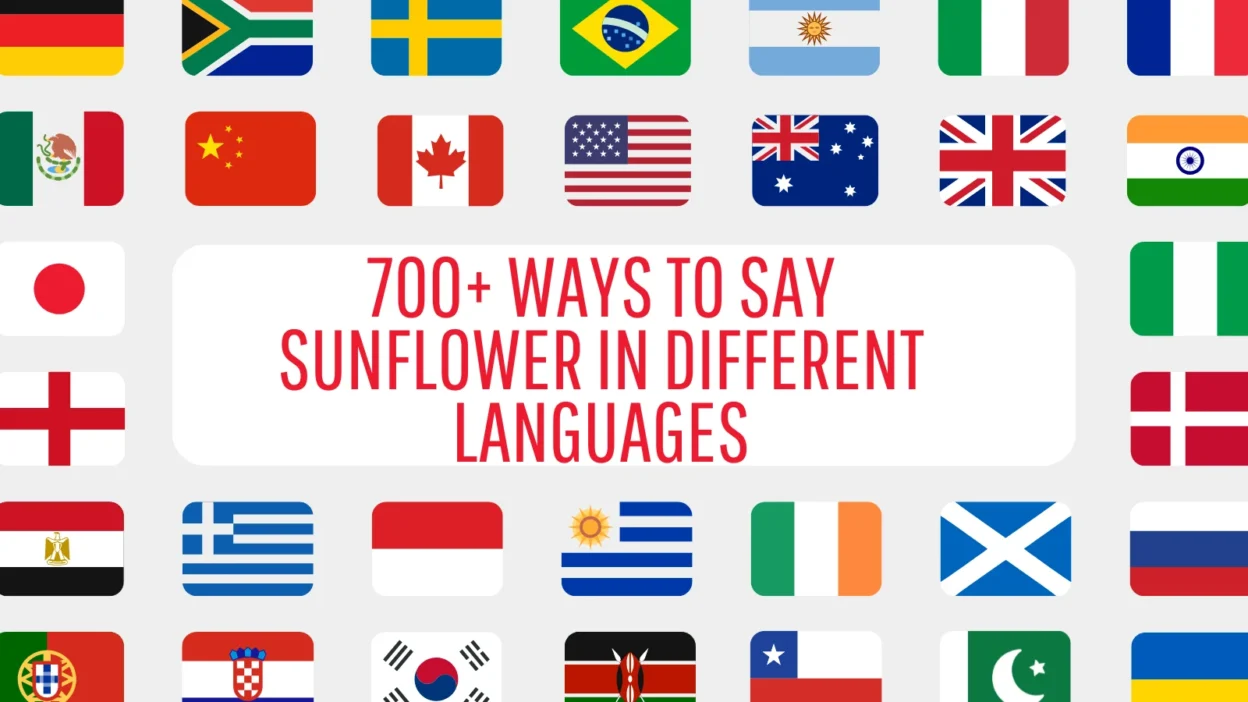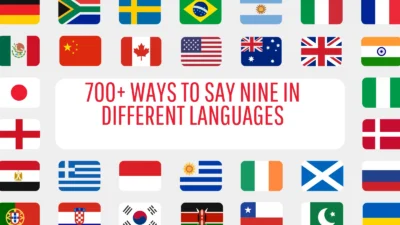The sunflower is a symbol of happiness, warmth, and sunshine. When someone searches for “sunflower in different languages,” they may be naming a brand, describing art, captioning a photo, or simply curious about how this vibrant flower is celebrated around the world.
This article gives you the translation of “sunflower” in 70 languages, with easy pronunciations and example sentences so you can confidently use it in conversation or writing.
How to Say Sunflower in 70 Different Languages
- Spanish (🇪🇸) – Girasol | Pronunciation: hee-rah-SOL
El girasol sigue al sol. (The sunflower follows the sun.) - French (🇫🇷) – Tournesol | Pronunciation: toor-nuh-SOL
Le tournesol est jaune et grand. (The sunflower is yellow and tall.) - Italian (🇮🇹) – Girasole | Pronunciation: jee-rah-SOH-leh
Il girasole cresce verso il sole. (The sunflower grows toward the sun.) - German (🇩🇪) – Sonnenblume | Pronunciation: ZON-en-bloo-meh
Die Sonnenblume ist wunderschön. (The sunflower is beautiful.) - Portuguese (🇵🇹) – Girassol | Pronunciation: zhee-rah-SOL
O girassol gira com o sol. (The sunflower turns with the sun.) - Dutch (🇳🇱) – Zonnebloem | Pronunciation: ZON-uh-bloom
De zonnebloem staat in bloei. (The sunflower is in bloom.) - Russian (🇷🇺) – Подсолнух (Podsolnukh) | Pronunciation: pud-SOL-nookh
Подсолнухи тянутся к солнцу. (Sunflowers stretch toward the sun.) - Ukrainian (🇺🇦) – Соняшник (Sonyashnyk) | Pronunciation: SOH-nyah-shnik
Соняшники ростуть на полі. (Sunflowers grow in the field.) - Polish (🇵🇱) – Słonecznik | Pronunciation: swaw-NECH-neek
Słonecznik rośnie wysoko. (The sunflower grows tall.) - Czech (🇨🇿) – Slunečnice | Pronunciation: sloo-NECH-nee-tseh
Slunečnice se otáčí za sluncem. (The sunflower turns to the sun.) - Slovak (🇸🇰) – Slnečnica | Pronunciation: sluh-NECH-nee-tsah
Slnečnica je krásna kvetina. (The sunflower is a beautiful flower.) - Hungarian (🇭🇺) – Napraforgó | Pronunciation: NAHP-rah-for-go
A napraforgó a nap felé fordul. (The sunflower turns to the sun.) - Romanian (🇷🇴) – Floarea-soarelui | Pronunciation: FLOH-ah-rah SWA-reh-loo-ee
Floarea-soarelui simbolizează bucuria. (The sunflower symbolizes joy.) - Greek (🇬🇷) – Ηλιοτρόπιο (Iliotropio) | Pronunciation: ee-lee-oh-TROH-pee-oh
Το ηλιοτρόπιο ακολουθεί τον ήλιο. (The sunflower follows the sun.) - Turkish (🇹🇷) – Ayçiçeği | Pronunciation: eye-chee-CHEH-ee
Ayçiçeği güneşe döner. (The sunflower turns to the sun.) - Arabic (🇸🇦) – عباد الشمس (‘Abbād al-shams) | Pronunciation: ab-BAD al-shams
عباد الشمس يتبع الشمس. (The sunflower follows the sun.) - Hebrew (🇮🇱) – חמנית (Chamanit) | Pronunciation: khah-ma-NEET
החמנית צומחת בשדה. (The sunflower grows in the field.) - Persian (🇮🇷) – گل آفتابگردان (Gol-e Āftābgardān) | Pronunciation: gol-e af-TAHB-gar-dan
گل آفتابگردان به خورشید نگاه میکند. (The sunflower looks at the sun.) - Hindi (🇮🇳) – सूरजमुखी (Soorajmukhi) | Pronunciation: SOO-raj-moo-khee
सूरजमुखी सूरज की ओर मुड़ता है। (The sunflower turns toward the sun.) - Urdu (🇵🇰) – سورج مکھی (Sooraj Mukhi) | Pronunciation: SOO-raj MUKH-ee
سورج مکھی سورج کی طرف رخ کرتی ہے۔ (The sunflower turns toward the sun.) - Bengali (🇧🇩) – সূর্যমুখী (Shurjomukhi) | Pronunciation: SHOOR-joh-moo-khee
সূর্যমুখী ফুল সূর্যের দিকে মুখ করে। (The sunflower faces the sun.) - Punjabi (🇮🇳) – ਸੂਰਜਮੁਖੀ (Soorajmukhi) | Pronunciation: SOO-raj-mookh-ee
ਸੂਰਜਮੁਖੀ ਫੁੱਲ ਸੂਰਜ ਵੱਲ ਮੂੰਹ ਕਰਦਾ ਹੈ। (The sunflower turns toward the sun.) - Tamil (🇮🇳) – சூரியகாந்தி (Sooriyakanthi) | Pronunciation: SOO-ree-yah-KAAN-thee
சூரியகாந்தி சூரியனைப் பின்பற்றுகிறது. (The sunflower follows the sun.) - Telugu (🇮🇳) – సూర్యకాంతి పుష్పం (Suryakanti Pushpam) | Pronunciation: SOOR-yah-KAAN-tee POO-shpam
సూర్యకాంతి పుష్పం సూర్యుని వైపు తిరుగుతుంది. (The sunflower turns toward the sun.) - Kannada (🇮🇳) – ಸೂರ್ಯಕಾಂತಿ (Sooryakanthi) | Pronunciation: SOOR-yah-KAAN-thee
ಸೂರ್ಯಕಾಂತಿ ಹೂವು ಸೂರ್ಯನ ಕಡೆ ತಿರುಗುತ್ತದೆ. (The sunflower turns toward the sun.) - Malayalam (🇮🇳) – സൂര്യകാന്തി (Sooryakanthi) | Pronunciation: SOOR-yah-KAAN-thee
സൂര്യകാന്തി സൂര്യനെ പിന്തുടരുന്നു. (The sunflower follows the sun.) - Marathi (🇮🇳) – सूर्यफूल (Sooryaphool) | Pronunciation: SOOR-yah-phool
सूर्यफूल सूर्याच्या दिशेने वळतो. (The sunflower turns toward the sun.) - Gujarati (🇮🇳) – સૂર્યમુખી (Sooryamukhi) | Pronunciation: SOOR-yah-mookh-ee
સૂર્યમુખી સૂર્ય તરફ વળે છે. (The sunflower turns toward the sun.) - Nepali (🇳🇵) – सूर्यमुखी (Sooryamukhi) | Pronunciation: SOOR-yah-moo-khee
सूर्यमुखी सूर्यतिर फर्कन्छ। (The sunflower turns toward the sun.) - Sinhala (🇱🇰) – සූරියකාන්ති (Sooriyakānthi) | Pronunciation: SOO-ree-yah-kaan-thee
සූරියකාන්ති යායාමෙන්ම සූරියයා දකිනවා. (The sunflower sees the sun.) - Chinese (🇨🇳) – 向日葵 (Xiàngrìkuí) | Pronunciation: shyahng-REE-kway
向日葵面向太阳。 (The sunflower faces the sun.) - Japanese (🇯🇵) – ひまわり (Himawari) | Pronunciation: hee-mah-WAH-ree
ひまわりは太陽に向かって咲きます。 (The sunflower blooms facing the sun.) - Korean (🇰🇷) – 해바라기 (Haebaragi) | Pronunciation: heh-BAH-rah-gee
해바라기는 태양을 향해 자랍니다. (The sunflower grows toward the sun.) - Vietnamese (🇻🇳) – Hoa hướng dương | Pronunciation: hwa hwoong-yoo-uhng
Hoa hướng dương quay về phía mặt trời. (The sunflower turns to the sun.) - Thai (🇹🇭) – ทานตะวัน (Thāntawan) | Pronunciation: tahn-tah-WAN
ดอกทานตะวันหันหาดวงอาทิตย์. (The sunflower turns to the sun.) - Lao (🇱🇦) – ດອກຕາແດດ (Dok ta daet) | Pronunciation: dok tah-daet
ດອກຕາແດດຫັນໄປຫາພຣະອາທິດ. (The sunflower faces the sun.) - Khmer (🇰🇭) – ផ្កាផ្ទាំងថ្ងៃ (Phka Phtang Thngai) | Pronunciation: pka ph-tang tngai
ផ្កាផ្ទាំងថ្ងៃដូចស្នេហា។ (The sunflower is like love.) - Indonesian (🇮🇩) – Bunga matahari | Pronunciation: BOO-nga MAH-tah-HAH-ree
Bunga matahari tumbuh ke arah matahari. (The sunflower grows toward the sun.) - Malay (🇲🇾) – Bunga matahari | Pronunciation: BOO-nga MAH-tah-HAH-ree
Bunga matahari menghadap matahari. (The sunflower faces the sun.) - Filipino (🇵🇭) – Mirasol | Pronunciation: mee-rah-SOL
Ang mirasol ay sumusunod sa araw. (The sunflower follows the sun.)
- Swahili (🇰🇪) – Ua wa alizeti | Pronunciation: oo-ah wah ah-lee-ZEH-tee
Ua wa alizeti hufuata jua. (The sunflower follows the sun.) - Zulu (🇿🇦) – Imbali yelanga | Pronunciation: eem-BAH-lee yeh-LAHN-gah
Imbali yelanga ibheke ilanga. (The sunflower faces the sun.) - Xhosa (🇿🇦) – Intyatyambo yelanga | Pronunciation: een-tyah-TYAHM-boh yeh-LAHN-gah
Intyatyambo yelanga ijongise elangeni. (The sunflower looks toward the sun.) - Sesotho (🇱🇸) – Lehlomela la letsatsi | Pronunciation: leh-lom-EH-lah lah leh-lah-tsay
Lehlomela le shebile letsatsi. (The sunflower is facing the sun.) - Amharic (🇪🇹) – ጸሓይ አበባ (Tsehayi Abeba) | Pronunciation: tseh-HI ah-BEH-bah
ጸሓይ አበባ ወደ ፀሐይ ታይታለች። (The sunflower looks at the sun.) - Somali (🇸🇴) – Ubax qorrax | Pronunciation: oo-bakh qor-rahs
Ubaxa qoraxda wuu la socdaa. (The sunflower follows the sun.) - Mongolian (🇲🇳) – Нарны цэцэг (Narny tsetseg) | Pronunciation: nar-nee tset-seg
Нарны цэцэг нарны зүг эргэдэг. (The sunflower turns toward the sun.) - Kazakh (🇰🇿) – Күнбағыс (Künbagys) | Pronunciation: koon-bah-GHIS
Күнбағыс күнге қарайды. (The sunflower faces the sun.) - Uzbek (🇺🇿) – Quyosh guli | Pronunciation: koo-yosh goo-lee
Quyosh guli quyoshga qaraydi. (The sunflower looks toward the sun.) - Tajik (🇹🇯) – Гули офтобпараст (Guli oftobparast) | Pronunciation: goo-lee of-tob-pah-RAST
Гули офтобпараст ба офтоб менигарад. (The sunflower looks at the sun.) - Pashto (🇦🇫) – د لمر ګل (Da lmar gul) | Pronunciation: da l-mar gul
د لمر ګل د لمر پر لور ګرځي. (The sunflower turns toward the sun.) - Kurdish (🇮🇶) – Gulê rojê | Pronunciation: goo-leh roh-JAY
Gulê rojê rojê dide. (The sunflower watches the sun.) - Tibetan (🇨🇳) – ཉི་མ་མེ་ཏོག (Nyima Metok) | Pronunciation: nyi-ma meh-tok
ཉི་མ་མེ་ཏོག་གཙོ་བོར་གཏོང་། (The sunflower blooms brightly.) - Hawaiian (🇺🇸) – Pua lā | Pronunciation: poo-ah lah
Pua lā e huli ana i ka lā. (The sunflower turns to the sun.) - Maori (🇳🇿) – Pua rā | Pronunciation: poo-ah rah
Ko te pua rā e anga ana ki te rā. (The sunflower faces the sun.) - Samoan (🇼🇸) – Fugalaʻau o le lā | Pronunciation: foo-nga-lau oh leh lah
E liliu le fugalaʻau o le lā i le lā. (The sunflower turns toward the sun.) - Tongan (🇹🇴) – Fua‘akau ʻo e lā | Pronunciation: foo-ah-ah-kow oh eh lah
ʻOku fili ʻe he fuaʻakau ʻo e lā e lā. (The sunflower chooses the sun.) - Fijian (🇫🇯) – Vunikau ni siga | Pronunciation: voo-nee-kow nee see-ngah
Na vunikau ni siga e vuki ki na siga. (The sunflower turns to the sun.) - Esperanto (🌍) – Sunfloro | Pronunciation: soon-FLO-roh
La sunfloro sekvas la sunon. (The sunflower follows the sun.) - Latin (🇻🇦) – Helianthus | Pronunciation: hel-ee-AN-thus
Helianthus solem sequitur. (The sunflower follows the sun.) - Basque (🇪🇸) – Eguzkilore | Pronunciation: eh-GOOTH-kee-lo-reh
Eguzkilorea eguzkiari begiratzen dio. (The sunflower looks at the sun.) - Catalan (🇪🇸) – Gira-sol | Pronunciation: zhee-rah-SOL
El gira-sol gira cap al sol. (The sunflower turns to the sun.) - Galician (🇪🇸) – Xirasol | Pronunciation: shee-rah-SOL
O xirasol mira cara ao sol. (The sunflower faces the sun.) - Breton (🇫🇷) – Bleunioù-an-heol | Pronunciation: bleu-nee-oh an hey-ol
Ar bleunioù-an-heol a sell ouzh an heol. (The sunflower looks at the sun.) - Irish (🇮🇪) – Lus na gréine | Pronunciation: looss nah GRAYN-yuh
Lus na gréine ag féachaint ar an ngrian. (The sunflower is looking at the sun.) - Scottish Gaelic (🏴) – Lus na grèine | Pronunciation: looss nah GRAYN-yuh
Tha lus na grèine a’ leantainn na grèine. (The sunflower follows the sun.) - Welsh (🏴) – Blodyn yr haul | Pronunciation: BLOH-din ur hile
Mae’r blodyn yr haul yn troi tuag at yr haul. (The sunflower turns toward the sun.) - Frisian (🇳🇱) – Sinneblom | Pronunciation: SIN-uh-blom
De sinneblom sjocht nei de sinne. (The sunflower looks at the sun.) - Icelandic (🇮🇸) – Sóley | Pronunciation: SOH-lay
Sóley snýr að sólinni. (The sunflower turns to the sun.) - Greenlandic (🇬🇱) – Seqineq naasoq | Pronunciation: seh-kee-nek NAH-sooq
Seqineq naasoq seqinermut saappoq. (The sunflower faces the sun.)
Conclusion
From Girasol in Spanish to Helianthus in Latin, the sunflower carries joy and sunshine across all languages. No matter where you are in the world, this golden bloom is a symbol of positivity, hope, and light. Now that you know how to say “sunflower” in 70 different languages, you can brighten your day—and others’—with just one word.



